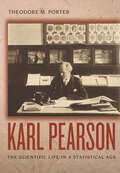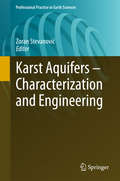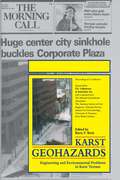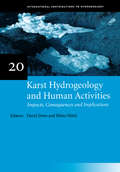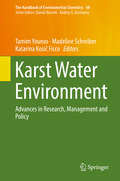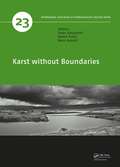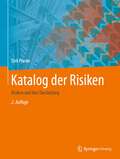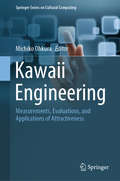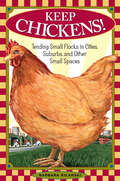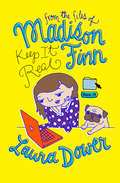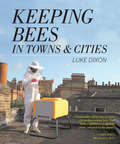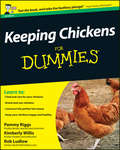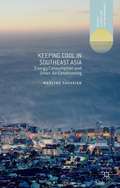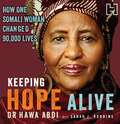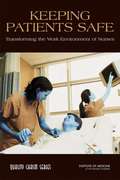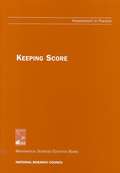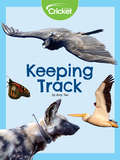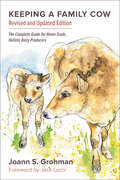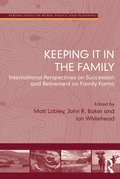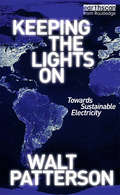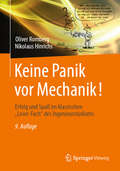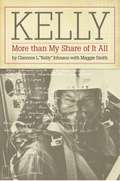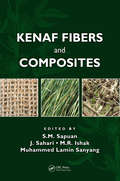- Table View
- List View
Karl Pearson: The Scientific Life in a Statistical Age
by Theodore M. PorterKarl Pearson, founder of modern statistics, came to this field by way of passionate early studies of philosophy and cultural history as well as ether physics and graphical geometry. His faith in science grew out of a deeply moral quest, reflected also in his socialism and his efforts to find a new basis for relations between men and women. This biography recounts Pearson's extraordinary intellectual adventure and sheds new light on the inner life of science. Theodore Porter's intensely personal portrait of Pearson extends from religious crisis and sexual tensions to metaphysical and even mathematical anxieties. Pearson sought to reconcile reason with enthusiasm and to achieve the impersonal perspective of science without sacrificing complex individuality. Even as he longed to experience nature directly and intimately, he identified science with renunciation and positivistic detachment. Porter finds a turning point in Pearson's career, where his humanistic interests gave way to statistical ones, in his Grammar of Science (1892), in which he attempted to establish scientific method as the moral educational basis for a refashioned culture. In this original and engaging book, a leading historian of modern science investigates the interior experience of one man's scientific life while placing it in a rich tapestry of social, political, and intellectual movements.
Karosserieentwicklung und -Leichtbau: Eine ganzheitliche Betrachtung von Design über Konzept- und Materialauswahlprinzipien bis zur Auslegung und Fertigung
by Xiangfan FangDas Buch behandelt alle wissenschaftlichen und technischen Aspekte der Karosserieentwicklung und des Karosserieleichtbaus. Es ist an Studierende der Fahrzeugtechnik und Ingenieure der Karosserieentwicklung in der Automobil- und Zuliefererindustrie adressiert, die das Thema erlernen, vertiefen und in den F&E Arbeiten einsetzen möchten. Hierzu soll ein umfassender und gleichzeitig tiefergehender Einblick in die Karosserieauslegung, -konstruktion, -berechnung und -fertigung sowie -Leichtbau vermittelt werden. Dabei wird zunächst großer Wert darauf gelegt, die mechanischen Grundprinzipien der Struktur analytisch zu verstehen. Damit sollen Ingenieure in der Lage sein, die Karosseriestruktur auch zunächst ohne FEM konzeptionell auszulegen. Ein weiteres wichtiges Ziel ist, die Wechselwirkungen zwischen den konstruktiven Konzepten für die Karosseriestruktur mit den aktuellen und zukünftigen Werkstoffen und den damit verbundenen Fertigungstechniken systematisch zu verknüpfen. Dabei werden analytische Methoden der Materialauswahl für den Leichtbau auf Grundlage der Mechanik erläutert. Darüber hinaus werden ausgehend von den theoretischen Grundlagen viele praktische Umsetzungsbeispiele mit unterschiedlichen Lösungsansätzen von verschiedenen OEMs aufgezeigt. Der Leser soll damit einen guten Überblick über die Karosserieentwicklung und den Leichtbau erhalten. Das Buch soll nicht nur den Stand der Technik wiedergeben, sondern auch den Leser zum Nachdenken zu eigenen Lösungen anregen. Es soll damit als ein nützliches Werkzeug für den Entwickler in der Automobil- und Zuliefererindustrie dienen.
Karst Aquifers—Characterization and Engineering
by Zoran StevanovićThis practical training guidebook makes an important contribution to karst hydrogeology. It presents supporting material for academic courses worldwide that include this and similar topics. It is an excellent sourcebook for students and other attendees of the International Karst School: Characterization and Engineering of Karst Aquifers, which opened in Trebinje, Bosnia & Herzegovina in 2014 and which will be organized every year in early summer. As opposed to more theoretical works, this is a catalog of possible engineering interventions in karst and their implications. Although the majority of readers will be professionals with geology/hydrogeology backgrounds, the language is not purely technical making it accessible to a wider audience. This means that the methodology, case studies and experiences presented will also benefit water managers working in karst environments.
Karst Geohazards: Engineering and Environmental Problems in Karst Terrane
by Barry F. BeckGeologists and geographers study how to develop how and where karst develops and how sinkholes form, but engineers must use this information to develop karst terrane. Over the past ten years, these multidisciplinary conferences on the applied aspects of karst hydrogeology and engineering have been successful in bringing together engineers, geologists, other scientists and government regulators who must safely establish human infrastructure on karst terrane whilst protecting the environment. The essences of these conferences has always been communciation between geologists and engineers with an emplasis on practical applications and case studies. This text contains the proceedings of the fifth conference on karst geohazards. It presents 65 papers that cover topics such as: groundwater contamination through sinkholes and the karst surface; stormwater drainage and flooding problems; and foundation considerations and improvements in karst.
Karst Hydrogeology and Human Activities: IAH International Contributions to Hydrogeology 20 (IAH - International Contributions to Hydrogeology #20)
by David Drew Heinz HötzlOne quarter of the world's population lives in karst terrains, yet karsts are highly vulnerable to stresses caused by human activity. This book surveys human impact on karst water, showing that the increasing pollution of the environment has, to a great extent, spoiled sensitive karst ecosystems. This text examines such consequences and offers proposals for future solutions and strategies. Part One provides an overview of the functioning of karsts and of human interaction with karst environments over several millennia. Part Two consists of a systematic examination of the major areas of human activity affecting karst waters, such as agriculture, industry, mining and water exploitation. Finally, Part Three views the effects on karst groundwater within a broader societal and legislative perspective and considers possible changes of methodology and approach.
Karst Water Environment: Advances In Research, Management And Policy (The Handbook of Environmental Chemistry #68)
by Tamim Younos Madeline Schreiber Katarina Kosič FiccoKarst aquifers are important sources of drinking water worldwide. This volume presents a discussion of the current state of knowledge on karst science, advances in karst mapping and karst aquifer monitoring technologies, case studies of karst aquifer assessment, and regulatory perspectives on land use and water management in karst environments. It offers valuable reference material for researchers involved in karst science and environmental studies, as well as a guide for experts at governmental agencies, scientists, engineers and other professionals involved in karst aquifer protection and the design of land and water management systems in karst areas around the globe.
Karst without Boundaries (IAH - Selected Papers on Hydrogeology)
by Zoran Stevanović Neven KrešićKarstified rocks of different lithology cover more than 10% of the continental surface of our planet. It is known that some 20% or even a few percent more of the global population largely depends on karstic groundwater but in many karst areas all over the world there are limited natural resources including absence of drinking waters. The problems o
Katalog der Risiken: Risiken und ihre Darstellung
by Dirk ProskeDie Risikolehre bewertet basierend auf empirischen Daten die potenziell negativen Konsequenzen von Entwicklungen und Handlungen. Sie stellt einen wichtigen Bestandteil der Entscheidungstheorie dar. Neben der Quantifizierung der negativen Konsequenzen gibt die Risikolehre auch die Unsicherheit der Bewertung an. Das Buch beginnt deshalb mit der Diskussion der Begriffe Unbestimmtheit, Komplexität, Katastrophe, Sicherheit und Risiko. Im zweiten Kapitel werden Risiken in natürliche, technische, gesundheitliche und soziale Risiken eingeteilt und zahlreiche Beispiele vorgestellt. Im dritten Kapitel werden verschiedene Risikoparameter eingeführt. Dabei wird der Entwicklung von einfachen Risikoparametern zu komplexeren Parametern gefolgt. Im vierten Kapitel wird die subjektive Risikobewertung behandelt. Im fünften Kapitel werden Lebensqualitätsparameter als höchste Form der Risikoparameter erläutert. Dieser Parameter ermöglicht den eleganten Vergleich der Effizienz von Sicherheitsmaßnahmen. Abschließend werden kurz juristische Grundlagen der Risikobewertung umrissen und Anwendungsbeispiele der Lebensqualitätsparameter diskutiert. Das Buch umfasst eine große Zahl von Bildern und Tabellen, die die Zusammenhänge verdeutlichen sollen. Das Buch besitzt daher den Charakter eines Kataloges.
Kawaii Engineering: Measurements, Evaluations, and Applications of Attractiveness (Springer Series on Cultural Computing)
by Michiko Ohkura“Kawaii” is a Japanese word that denotes “cute,” “lovable,” or “charming” although it does not have exactly the same meaning as those adjectives. This book proposes engineering methodologies for systematic measurement of the affective perception of kawaii, by using virtual reality and biological signals, and discusses the effectiveness of kawaii engineering for designing industrial products and services. Kawaii can draw sympathy from people and can embody a special kind of cute design, which reduces fear and makes dull information more acceptable and appealing. Following the introduction of the background of kawaii engineering in Chapter 1, Chapters 2 and 3 describe experiments on the systematic measurement and evaluation methods for kawaii products and affective evaluation experiments. Chapter 4 proposes a mathematical model to identify the physical attributes that determine kawaii in motion. Chapters 5 and 6 explain research that uses biological signals and eye-tracking. After a brief survey of psychological research on kawaii and cuteness in Chapter 7, Chapters 8 and 9 introduce the use of spoons designed to stimulate the appetite of the elderly and the practical implementation of an emotion-driven camera. Chapters 10–14 explain experimental research that examines kawaii perception of people from various cultural backgrounds. Kawaii Engineering will appeal to those who work on affective computing, product design, user experience design, virtual reality, and biological signals.
Keep Chickens!: Tending Small Flocks in Cities, Suburbs, and Other Small Spaces
by Barbara KilarskiNo matter how small your lot is, you can keep chickens and enjoy fresh eggs every morning. Barbara Kilarski shares her passion for poultry as she fills this guide with tips and techniques for successfully raising chickens in small spaces. Spotlighting the self-sufficient pleasures of tending your own flock, Kilarski offers detailed information on everything from choosing breeds that thrive in tight quarters and building coops to providing medical care for sick animals. You’ll have fun as you keep happy and productive chickens.
Keep It Real (From the Files of Madison Finn #19)
by Laura DowerMadison is tired of all the secrets--why can't everyone just keep it real?Madison's not sure if her imagination is working overtime. Everyone--including her mom--is acting different! When Maddie checks out a new feature on TweenBlurt.com, she finds out her keypal, Bigwheels, has been keeping things from her. And then Hart sends a mean email about Madison--is he keeping secrets too?The truth is not always obvious, and Maddie isn't sure how to get the answers she wants. When her mom tells her a secret about Poison Ivy's family, Maddie knows it's serious news, and she's tempted to share it--especially when Ivy is acting mean. But some information is not ours to share . . .
Keeping Bees in Towns and Cities
by Luke DixonKeeping Bees in Towns and Cities features everything an urbanite needs to know to start keeping bees: how to select the perfect hive, how to buy bees, how to care for a colony, how to harvest honey, and what to do in the winter. Urban beekeeping has particular challenges and needs, and this book highlights the challenges and presents practices that are safe, legal, and neighbor-friendly. The text is rounded out with profiles of urban beekeepers from all over the world, including public hives at the Maryland Center for Horticulture, beekeeping on an office balcony in Melbourne, Australia, and a poolside hive at a hotel in Vancouver, British Columbia.
Keeping Chickens For Dummies
by Kimberley Willis Ludlow Pammy RiggsPractical how-to advice for keeping chickens "For me, raising chickens, for eggs and meat, has been one of the most enjoyable aspects of our family farm. I am a great admirer of "chicken whisperer" Pammy Riggs, and with her two co-authors she has produced an admirably thorough guide to enjoying the pleasures and avoiding the pitfalls of keeping chickens. Get the book, and take the feathery plunge!"- Hugh Fearnley-Whittingstall Keeping Chickens For Dummies provides you with an introduction to all aspects of keeping chickens, from constructing a hutch to the correct feeding regime. It offers expert advice straight from the River Cottage 'Chicken Whisperer', so whether you're looking to raise chickens for eggs, meat, or just the entertainment value and fun - Keeping Chickens For Dummies is the perfect place to start.Keeping Chickens For Dummies:Shows you how to keep chickens in different conditions Offers guidance on choosing and purchasing chickens Gives great step-by-step advice on constructing the right housing Provides expert advice on how to feed and care for your chickens
Keeping Cool in Southeast Asia
by Marlyne SahakianAgainst the backdrop of the environmental impact of household electricity consumption and the history of cooling practices, Marlyne Sahakian considers how people keep cool, from Metro Manila to other mega-cities in Southeast Asia.
Keeping Hope Alive: How One Somali Woman Changed 90,000 Lives
by Dr. Hawa AbdiFor the last twenty years, Dr Hawa Abdi and her daughters have run a refugee camp on their family farm not far from Mogadishu which has grown to shelter 90,000 displaced Somalis: men, women, and children in urgent need of medical attention. As Islamist militia groups have been battling for control of the country creating one of the most dire human rights crises in the world, Dr. Abdi's camp is a beacon of hope for the Somalis, most of whom have no proper access to health care. She was recently held hostage by a militant groups who threatened her life and told her that because she's a woman she has no right to run the camp. She refused to leave.This is not just the story of a woman doctor in a war torn Islamic country risking her life daily to minister to thousands of desperate people, it's also an inspiring story of a divorced woman and her two daughters, bound together on a mission to rehabilitate a country.
Keeping Patients Safe: Transforming the Work Environment of Nurses
by Institute of Medicine of the National AcademiesBuilding on the revolutionary Institute of Medicine reports To Err is Human and Crossing the Quality Chasm, Keeping Patients Safe lays out guidelines for improving patient safety by changing nurses working conditions and demands. Licensed nurses and unlicensed nursing assistants are critical participants in our national effort to protect patients from health care errors. The nature of the activities nurses typically perform – monitoring patients, educating home caretakers, performing treatments, and rescuing patients who are in crisis - provides an indispensable resource in detecting and remedying error-producing defects in the U.S. health care system. During the past two decades, substantial changes have been made in the organization and delivery of health care - and consequently in the job description and work environment of nurses. As patients are increasingly cared for as outpatients, nurses in hospitals and nursing homes deal with greater severity of illness. Problems in management practices, employee deployment, work and workspace design, and the basic safety culture of health care organizations place patients at further risk. This newest edition in the groundbreaking Institute of Medicine Quality Chasm series discusses the key aspects of the work environment for nurses and reviews the potential improvements in working conditions that are likely to have an impact on patient safety.
Keeping Score: Assessment in Practice
by Ann ShannonKeeping Score is a brief and well organized consideration of effective authentic assessment.-- Teacher Education Materials Project online
Keeping Track
by Amy TaoDid you know that scientists can track animals? By tracking animals, scientists can see where animals migrate to and from. These trackers can be big or small and are different depending on the kind of animal being tracked. Learn about the different technology that is used for tracking!
Keeping a Family Cow: The Complete Guide for Home-Scale, Holistic Dairy Producers, 3rd Edition
by Joann S. GrohmanThe cow is the most productive, efficient creature on earth. She will give you fresh milk, cream, butter, and cheese, build human health and happiness, and even turn a profit for homesteaders and small farmers who seek to offer her bounty to the local market or neighborhood. She will provide rich manure for your garden or land, and will enrich the quality of your life as you benefit from the resources of the natural world. Quite simply, the family that keeps a cow is a healthy family.Originally published in the early 1970s as The Cow Economy and reprinted many times over, Keeping a Family Cow has launched thousands of holistic small-scale dairy farmers and families raising healthy cows in accordance with their true nature. The book offers answers to frequently asked questions like, &‘Should I get a cow?&’ and &‘How Much Space do I need?&’ in addition to extensive information on:• The health benefits of untreated milk;• How to milk a cow effectively and with ease;• Choosing your dairy breed;• Drying off your cow;• Details on calving and breeding;• The importance of hay quality and how to properly feed your cow;• Fencing and pasture management;• Housing, water systems, and other supplies;• Treating milk fever and other diseases and disorders;• Making butter, yogurt, and cheese, and, of course . . .• . . . Everything else the conventional dairy industry doesn&’t tell us!Now revised and updated to incorporate new information on the raw milk debate, the conversation about A1 vs. A2 milk, fully grassfed dairies, more practical advice for everyday chores, and updated procedures for cow emergencies.Keeping a Family Cow has not only stood the test of time, it still remains the go-to inspirational manual for raising a family milk cow nearly forty years after its first publication. Joann Grohman has a lifetime of practical experience that has been bound into this one volume and presented in the spirit of fun and learning.
Keeping it in the Family: International Perspectives on Succession and Retirement on Family Farms (Perspectives On Rural Policy And Planning Ser.)
by Matt Lobley John R. Baker Ian WhiteheadAs the largest group of natural resource managers on the planet, farmers are at the interface of the changing relationship between humans and the environment. Typically organised around what might be considered the most basic of social units, for generations the family farm has survived wide-ranging exogenous challenges, frequently preserving the line of succession to the next of kin. Now as we face major questions about how we use land and the impact of our land use on the global environment, farming once again faces a challenging and uncertain future. This book draws on the experiences of farmers in Australia, New Zealand, North America, Japan and the EU to examine the special features of family farms and, in particular, the tradition of succession which has enabled them to continue to have such a strong presence in the world today.
Keeping the Lights On: Towards Sustainable Electricity
by Walt Patterson�This is such a timely book. Combining extraordinary historical insight with the sharpest analysis of where we are now, Walt Patterson carves out the most applied and practical of 'road maps' as to where we need to go if we are to deliver a genuinely sustainable electricity system for the future. As we go into a period of considerable turbulence, primarily because of the impacts of climate change, Keeping The Lights On will undoubtedly be seen as a very well informed Guidebook.� JONATHON PORRITT CBE, CHAIR, UK SUSTAINABLE DEVELOPMENT COMMISSION �A very important and timely book. Walt Patterson persuasively challenges traditional assumptions about how we think of energy and electricity, and presents an exciting vision of an innovative and sustainable future.� NICK MABEY, CHIEF EXECUTIVE, E3G (THIRD GENERATION ENVIRONMENTALISM), FORMER SENIOR ADVISER IN THE UK PRIME MINISTER�S STRATEGY UNIT �Walt has got this exactly right. It should be compulsive reading, if not compulsory reading, for all politicians and other players that determine or have a role to play in energy policy and, more importantly, in tackling climate change. Knowing what we know now, you would not implement such a wasteful and polluting electricity system as centralized power generation. As Walt has indicated, we do have to overcome the grid mindset of those who should know better.� ALLAN JONES MBE, CHIEF EXECUTIVE OFFICER, LONDON CLIMATE CHANGE AGENCY �What can I say? Clearly thought out, simply written, and straight to the heart of the major issues in energy today. I can�t think of anyone else who could bring together the technology, the economics, and the basic human relationship with energy that Walt has here. This is really great stuff.� RONAN PALMER, CHIEF ECONOMIST, UK ENVIRONMENT AGENCY �Fashions come and fashions go in the energy world. Security of supply, climate change and market liberalization have all vied for our attention. It�s good to have one voice that�s stayed constant over thirty years of turbulence and change. Keeping The Lights On distils Walt Patterson�s thinking over the last three decades. As ever, he provokes us to re-examine our own thinking about energy policy. Essential reading as we face up to new challenges.� PROFESSOR JIM SKEA OBE, RESEARCH DIRECTOR, UK ENERGY RESEARCH CENTRE 'Even more important now than when first released.' Energy News In Keeping The Lights On, Walt Patterson starts from a simple premise: that we are making a mess of energy, and this is endangering the planet. Using accessible, everyday language Patterson describes how we could do much better, outlining a different way to think about energy, what we want from it and how we get it. Drawing on over 35 years of work from one of the leading voices in the field, Keeping The Lights On explains how we could go about improving energy security and services while reducing costs and vulnerability, globally and rapidly. The book discusses the timely and heated debates surrounding energy and power, and emphasizes that electricity is about infrastructure; we have to stop treating it as a commodity. The result is a comprehensive introduction to the most important issues, providing the reader with innovative and expert ideas and solutions. Published with Royal Institute of International Affairs.
Keine Panik vor Mechanik!: Erfolg und Spaß im klassischen "Loser-Fach" des Ingenieurstudiums
by Oliver Romberg Nikolaus HinrichsDer Begleiter durch das klassische "Loserfach" im Ingenieurstudium. Inhalt des Buches sind die Grundlagen der Mechanik, wie sie im ingenieurwissenschaftlichen Grundstudium behandelt werden, also Statik, Festigkeitslehre, Kinematik und Kinetik, in unkonventioneller, humorvoller Darstellung mit 300 Cartoons und Zeichnungen sowie 99 Übungsaufgaben mit ausführlichen Lösungen. Nach dem Motto: "Schluss mit dem Prüfungsdurchfall!" bleibt trotz der lockeren Darstellungsweise die Korrektheit des Inhalts nicht auf der Strecke.
Kelly: More Than My Share of It All
by Clarence L. JohnsonClarence L. "Kelly" Johnson led the design of such crucial aircraft as the P-38 and Constellation, but he will be more remembered for the U-2 and SR-71 spy planes. His extraordinary leadership of the Lockheed "Skunk Works" cemented his reputation as a legendary figure in American aerospace management.From the Trade Paperback edition.
Kelvin Probe Force Microscopy: Measuring And Compensating Electrostatic Forces (Springer Series in Surface Sciences #48)
by Sascha Sadewasser Thilo GlatzelThis book provides a comprehensive introduction to the methods and variety of Kelvin probe force microscopy, including technical details. It also offers an overview of the recent developments and numerous applications, ranging from semiconductor materials, nanostructures and devices to sub-molecular and atomic scale electrostatics.In the last 25 years, Kelvin probe force microscopy has developed from a specialized technique applied by a few scanning probe microscopy experts into a tool used by numerous research and development groups around the globe. This sequel to the editors’ previous volume “Kelvin Probe Force Microscopy: Measuring and Compensating Electrostatic Forces,” presents new and complementary topics.It is intended for a broad readership, from undergraduate students to lab technicians and scanning probe microscopy experts who are new to the field.
Kenaf Fibers and Composites
by Muhammed Lamin Sanyang S. M. Sapuan J. Sahari M. R. IshakKenaf fiber is gaining attention as an alternative reinforcement for composite products due to low cost, reduced environmental impact, and attractive mechanical properties. Kenaf Fibers and Composites covers the breadth of these exciting materials, from raw material preparation to application in a variety of products. It discusses fiber characterization and properties, how to prepare kenaf-based composites, and design, manufacturing, and applications. It also covers hybrid fiber composites, kenaf fiber thermosetting composites, kenaf fiber thermoplastic composites, kenaf fibers in various lengths, and forms and arrangements such as particulates, continuous roving, and woven fabrics. Cellulose-based kenaf composites and kenaf fiber-filled biopolymer composites are presented.
